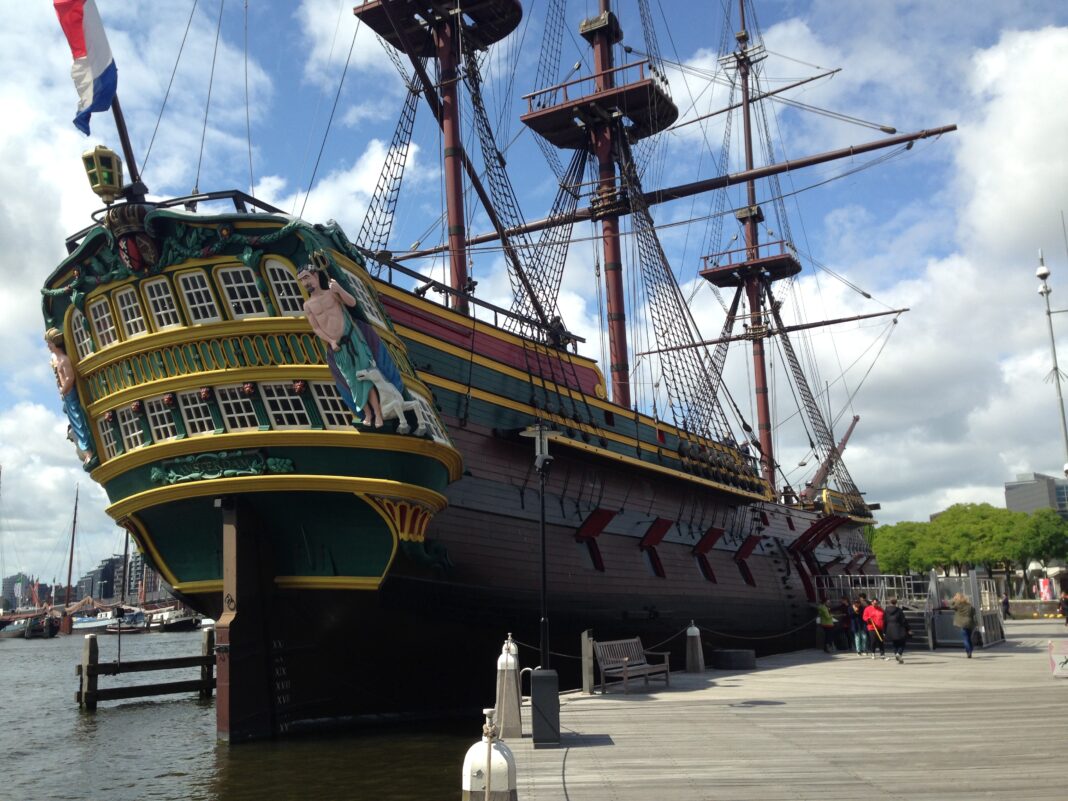We sometimes say about something that hasn’t worked out twice, ‘third time lucky.’ For the unfortunate crew of the Dutch East India Company ship Amsterdam, it was a case of third time very unlucky.
The company was founded in 1602, with settlements and forts in the East Indies. It was known as the VOC, the Dutch name of the company being Vereenndige Oost-Indische Compagnie. The ships that conducted the two-way trade were called Spiegelretourschip – Mirror Return ships. On the way out they would carry building materials such as bricks, weapons and gold and silver coins to buy goods. On the way back they carried those goods, porcelain, spices and fabrics. An outward voyage would take anything up to eight months, with nearly 250 men aboard. The return journey carried about 70 men.
The Amsterdam was a new ship, with its maiden voyage due to start at the Island of Texel, the largest of the West Frisian islands and a regular starting point for voyages. The destination was Batavia, now Jakarta, in Indonesia. Founded by the Dutch in 1619, it became the VOC main base for trade in Asia. For this, its first journey, Amsterdam was under the command of 33 year old Willem Klump, with a crew of 203, 127 soldiers and 5 fare-paying passengers. In its hold were stones for ballast, wine, pens and paper, clay pipes, European textiles, household goods and 27 chests of silver coins. It was a cargo worth probably £3 million at current values.
The voyage began on November 15 1748, but didn’t get very far, being forced back into port by strong winds on November 19. The winter weather was no better when the second attempt was made on November 21. Amsterdam was forced back to its home port on December 6. After Christmas at home, the third attempt began on January 8 1749. A severe westerly storm hampered progress through the English Channel and they got no further than off the coast of Eastbourne. To make matters worse an epidemic badly affected the crew; 50 died and 40 were gravely ill. Captain Klump wanted to try to get to Portsmouth for repairs, the crew wanted to beach the ship and get away to safety. It was, in effect, a mutiny. Sadly, the cabin boy, Adrian Wegevaren, was shot and killed during the uprising. It was his 16th birthday.
Then, one of the worst things that could happen to a ship happened: the keel hit the seabed and the rudder broke off, leaving them unable to navigate and at the mercy of the storm. Helpless, they were washed along the south coast, the situation not improved by the crew ransacking the wine from the cargo. Finally, on January 26, they were driven ashore at Bulverhythe, about three miles west of Hastings, where she began to sink into the mud.
Men from Hastings soon became aware of the disaster happening close by. It was a Sunday, so many left church to see what could be done. For some it was a case of doing their best to help the crew of the stricken vessel. For others, no doubt, the idea was to help themselves to whatever could be salvaged. The silver coins were soon removed and taken into custody for safe keeping. Meanwhile, fighting had broken out between different gangs, who were trying to help themselves to as much loot as possible. It took the arrival of a troop of soldiers to restore order.
Bulverhythe beach is now in what was an ancient river valley, which had become covered up with a deep layer of clay and peat. It was into this that Amsterdam settled, to a depth of nearly 30 feet. Everything above the top of the hull was lost, but even today, about two thirds of the hull is still buried in the mud, which has had the effect of preserving what is within. At very low tides the tops of the oak timbers protrude above the beach and can be visited. This was known as a tourist attraction in the19th century, and treasure hunters had made efforts, some successful, some not, to recover the remains of the valuable cargo. Even now, what is left is the most complete example of a Dutch East India ship to have survived.
In 1969, when a new sewer outlet was being built, workmen did a terrible thing. They dug into the wreck with a mechanical digger. Not good archaeological practice! They found remains of the rigging, plates, pipes and bronze cannon. There was nothing to be done to prevent such vandalism, because shipwrecks had no legal protection until 1974. Since then, more sensitive work has been undertaken, generally by divers. At one point a metal frame was built around the hull, to keep the tide out and allow work under slightly easier circumstances. Vast numbers of artefacts have since been accumulated, some of which are shown at the Shipwreck Museum in Hastings. One of the anchors was recovered and is now on display at St. Katharine’s Dock, near the Tower of London. It’s amusing to note that when 18th century bottles of wine were discovered, duty was payable on them.
Amsterdam isn’t the only item of interest on Bulverhythe beach. In the same area are ancient rocks with dinosaur prints and fossil fish, and the remnants of a prehistoric forest.
Image Credits: Ynmes https://commons.wikimedia.org/wiki/File:Amsterdam_%28ship,_1990%29_-_museum_3.JPG https://creativecommons.org/licenses/by-sa/2.5/deed.en.



